Introduction
The Polymer Fluids Group has developed a novel, oscillatory flow reactor with Smooth Periodic Constrictions for meso-scale (millilitre) applications. The oscillatory flow meso-reactor offers equally good mixing to the “conventional” sharp edges design, and shows good performance in multiphase flow. However, the oscillatory flow meso-reactor requires no internal baffle support structure (Figure 1), and has more homogeneous shear rate, making it potentially suitable for small-scale multiphase applications such as screening reactions, precipitation and crystallisation.
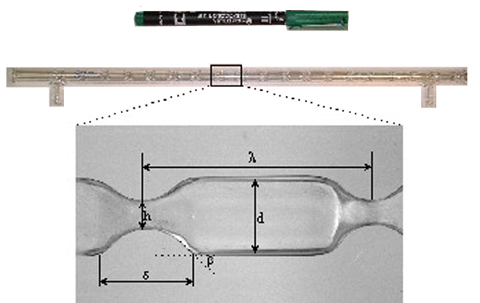 |
|
Figure 1 - Image of the oscillatory flow meso-reactor, showing the Smooth Periodic Constrictions. These vessels, manufactured in glass, include circulation jackets to allow heating and cooling of meso-scale reactions. |
The prototype of the continuous meso-reactor consists of an array of 10 glass jacketed tubes, a magnetic shaker and a set of tanks and syringe pumps (figure 2). The internal volume of the reactor when fully operational is less than 150 millilitre. This reactor is especially recommended for screening reactions on the time scale of minutes-to-hours for plug flow. The plug flow would assure maximum selectivity. In terms of industrial production, it is appropriate for the production of fine chemicals and active pharmaceutical ingredients in the kg-per-day scale. Higher production can be obtained by scaling-out the number of units. Ultimately, the reactor can be made from a disposable material, which would represent a great savings in the operational costs of value-added products.
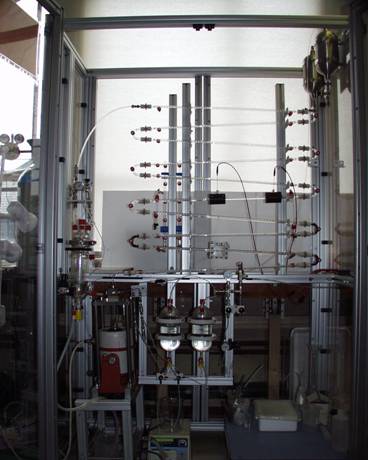 |
|
Figure 2 - The prototype continuous oscillatory flow meso-reactor. |
Fluid mechanics in the meso-reactor
When oscillatory flow is applied in the meso-reactor, a single vortex pair forms downstream of the constrictions, and propagates in the cavity until the flow reverses. This is seen in the PIV animation below (Figure 3). The experimentally obtained values are compared with results obtained from three-dimensional numerical simulations using Fluent software (Figure 4 below). In both cases, the flow Reynolds and Strouhal numbers were Reo=312, and St=0.4. Clearly, the simulation provides a good prediction of the flow patterns for the oscillatory flow within a meso-reactor.
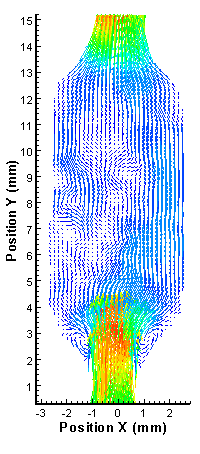 |
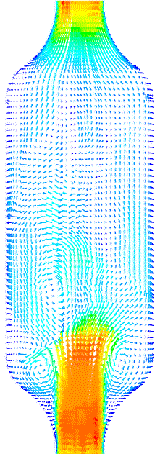 |
|
Figure 3. Experimental PIV measurements. |
Figure 4. Numerical flow simulation. |
Multiphase flow in the meso reactor
1. Liquid-liquid mixing
The vortex mixing mechanism and the resulting high shear rate in the meso-reactor give good performance in liquid-liquid mixing (e.g. oil and water). Varying the oscillation frequency and amplitude can be used to control the droplet size, as seen in Figures 5-7 below.
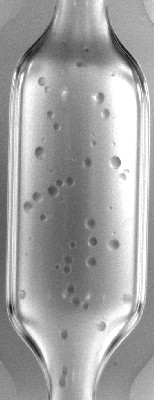 |
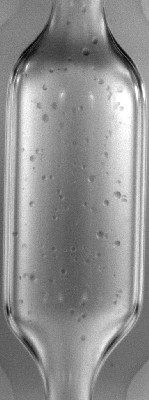 |
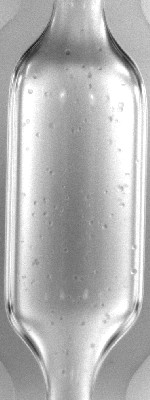 |
|
Figure 5. Oil droplets formed by oscillations at frequency 6Hz and amplitude 2mm. |
Figure 6. Oscillations at frequency 6Hz and amplitude 3mm. |
Figure 7. Oscillations at frequency 10Hz and amplitude 2mm. |
2. Suspension of particles
Particles can be suspended e.g. in liquids in stirred vessels, turbulent pipe flow and fluidisation by using steady flow. Oscillatory flow in the meso-reactor as well as in the “conventional” sharp-edged reactor can also be used for this purpose. The meso-reactor has the ability to keep 40 % (v/v) of ion-exchange particles completely suspended, as seen on Figure 7 below. Particles are easier to suspend with a horizontal rather than vertical OFR tube orientation.
 |
|
Figure 8. Suspension of 40% (v/v) of ion-exchange particles in the vertical meso-reactor (particles are superimposed with the velocity vectors of the liquid phase as determined from PIV). |

